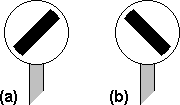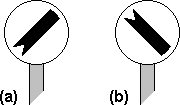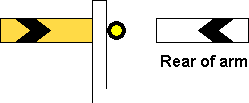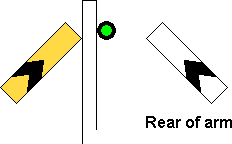|
|
|
|
|
|
In July 1927, a banner repeater was provided to repeat the Down Main distant signal at Haywards Heath North (Southern Railway). The banner had a yellow fishtailed arm on a black background and was surmounted by the letter "R" [7.38 & 7.39].
 |
 |
|
[7.38] Fishtailed Banner Repeater ('on').
Area: Haywards Heath North, SR Usage: Low Status: Historical |
[7.39] Fishtailed Banner Repeater ('off').
Area: Haywards Heath North, SR Usage: Low Status: Historical |
|---|
In May 1928, the Southern Railway installed a banner repeater signal with a black arm at Wandsworth Common [7.40 & 7.41]. The Ministry of Transport agreed on 26 September 1929 that banner repeaters should have black arms [7.40 - 7.43] to distinguish them from illuminated disc shunting signals (see Section 4).
 |
 |
|
[7.40] Banner Repeater with Black Arm ('on').
Area: All Areas Usage: High Status: Obsolescent |
[7.41] Banner Repeater with Black Arm ('off') ( (a) - lower quadrant type; (b) - upper quadrant type ).
Area: All Areas Usage: High Status: Obsolescent |
|---|---|
 |
 |
|
[7.42] Fishtailed Banner Repeater with Black Arm ('on').
Area: All Areas Usage: Medium Status: Historical |
[7.43] Fishtailed Banner Repeater with Black Arm ('off') ( (a) - lower quadrant type; (b) - upper quadrant type ).
Area: All Areas Usage: Medium Status: Historical |
If a semaphore signal had both a stop and a distant arm and a banner repeater was required, then normally both arms were repeated [7.44].
A 'splitting' banner repeater may be provided on the approach to a junction signal (semaphore or colour light) to give drivers an earlier indication of routeing. A splitting banner repeater comprises a separate banner for each route, each positioned beside the other. If the routes are of a similar speed then the banners are mounted at the same height [7.45]; otherwise, they are stepped in height according to the relative speeds of the routes [7.46].
The resignalling at Glasgow St. Enoch (LMS) in May 1933 had, unusually, provided fishtailed banner repeaters on approach to two three-aspect colour light stop signals situated on the North Curve approach to the station. Each banner repeater remained 'on' (see [7.42]) while the relevant colour light signal displayed either a red or a yellow aspect, changing to 'off' (see [7.43]) only when the signal displayed a green aspect. They were provided for propelling movements.
A repeater signal at Shafton Junction (London Midland Region), situated on the through siding from Brierley Junction, comprised a miniature semaphore distant signal with a board attached to the post, bearing a black letter "R" on a yellow background [7.47]. The repeater signal in 'off' position [7.48] indicated that the Home signal located 256 yards (234 metres) beyond was 'off' but drivers had to be prepared to stop at the Down Main Starting signal beyond.
 |
 |
|
[7.47] Semaphore Repeater Signal ('on').
Area: Shafton Junction Usage: Low Status: Historical |
[7.48] Semaphore Repeater Signal ('off').
Area: Shafton Junction Usage: Low Status: Historical |
|---|
A unique form of repeater signal was provided at Exeter City Basin (Western Region) in 1957. It repeated a semaphore signal that controlled the exit from the Basin branch at the top of a steep incline and which was obscured by the curvature of the line. The arm of the repeater signal was coloured yellow with a black chevron but was square-ended, not fishtailed [7.49 & 7.50]. Drivers of trains loaded with wagons would wait until the repeater signal was 'off', giving them a clear run onto the main line at the top of the bank.
 |
 |
|
[7.49] Semaphore Repeater Signal ('on').
Area: Exeter City Basin Usage: Low Status: Historical |
[7.50] Semaphore Repeater Signal ('off').
Area: Exeter City Basin Usage: Low Status: Historical |
|---|
A derivative of the L&SWR type of semaphore repeater signal (see [7.9 & 7.10]) was mounted under the platform canopy at Southfields station (Southern Region). The painted silhouette of a signal post on its white backboard was more contemporary in appearance, and the arm worked in the upper quadrant [7.51 & 7.52].
 |
 |
|
[7.51] Semaphore Repeater Signal ('on').
Area: Southfields Usage: Low Status: Historical |
[7.52] Semaphore Repeater Signal ('off').
Area: Southfields Usage: Low Status: Historical |
|---|
The emergence of fibre-optic signal technology in the early 1980s offered the prospect of a replacement form of banner repeater with no moving parts, for better reliability. Two fibre-optic banner repeaters were provided on the Down Stour line between Birmingham New Street and Wolverhampton (London Midland Region) in April 1984 for evaluation purposes. The first of these was installed at Smethwick Rolfe Street, repeating signal number NS339. It presented drivers with a display similar to the traditional electro-mechanical form of banner repeater (see [7.40 & 7.41]), except that the black and white areas were transposed so that the 'banner' appeared as an area of white light against a dark background [7.53 & 7.54]. Soon after that, the banner repeater for signal number WN112 at Wolverhampton was replaced by a fibre-optic equivalent that reproduced the customary display of a dark banner against a light background [7.55 & 7.56], and this format was chosen for all subsequent installations of fibre-optic banner repeaters (as well as later LED variants). The banner repeater at Smethwick Rolfe Street with the inverted displays was replaced by the standard fibre-optic type in June 1987.
 |
 |
|
[7.53] Experimental Banner Repeater ('on').
Area: Smethwick Rolfe Street Usage: Low Status: Historical |
[7.54] Experimental Banner Repeater ('off').
Area: Smethwick Rolfe Street Usage: Low Status: Historical |
|---|---|
 |
 |
|
[7.55] Banner Repeater ('on').
Area: All Areas Usage: High Status: Current |
[7.56] Banner Repeater ('off').
Area: All Areas Usage: High Status: Current |
In 1992, the provision of fishtailed banner repeaters (see [7.42 & 7.43]) for distant signals was discontinued for new works.
As an alternative to a splitting banner repeater (see [7.45 & 7.46]), a 'banner junction indicator' (BJI) may be provided. This consists of a single banner repeater co-located with a preliminary route indicator (see [6.62 & 6.63]) to give an indication of routeing.
|
|